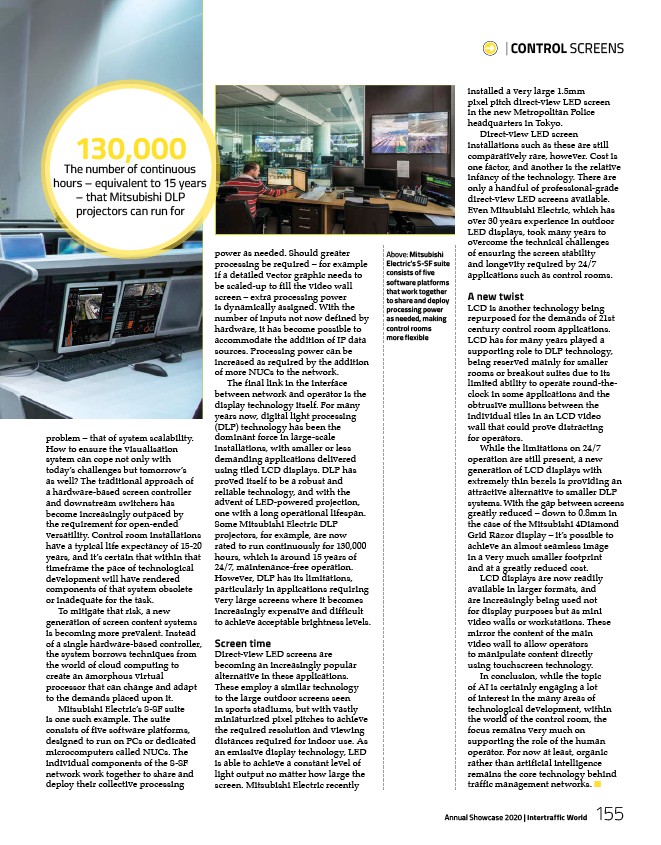
| CONTROL SCREENS
Above: Mitsubishi
Electric’s S-SF suite
consists of five
software platforms
that work together
to share and deploy
processing power
as needed, making
control rooms
more flexible
Annual Showcase 2020 | Intertraffic World 155
problem – that of system scalability.
How to ensure the visualisation
system can cope not only with
today’s challenges but tomorrow’s
as well? The traditional approach of
a hardware-based screen controller
and downstream switchers has
become increasingly outpaced by
the requirement for open-ended
versatility. Control room installations
have a typical life expectancy of 15-20
years, and it’s certain that within that
timeframe the pace of technological
development will have rendered
components of that system obsolete
or inadequate for the task.
To mitigate that risk, a new
generation of screen content systems
is becoming more prevalent. Instead
of a single hardware-based controller,
the system borrows techniques from
the world of cloud computing to
create an amorphous virtual
processor that can change and adapt
to the demands placed upon it.
Mitsubishi Electric’s S-SF suite
is one such example. The suite
consists of five software platforms,
designed to run on PCs or dedicated
microcomputers called NUCs. The
individual components of the S-SF
network work together to share and
deploy their collective processing
power as needed. Should greater
processing be required – for example
if a detailed vector graphic needs to
be scaled-up to fill the video wall
screen – extra processing power
is dynamically assigned. With the
number of inputs not now defined by
hardware, it has become possible to
accommodate the addition of IP data
sources. Processing power can be
increased as required by the addition
of more NUCs to the network.
The final link in the interface
between network and operator is the
display technology itself. For many
years now, digital light processing
(DLP) technology has been the
dominant force in large-scale
installations, with smaller or less
demanding applications delivered
using tiled LCD displays. DLP has
proved itself to be a robust and
reliable technology, and with the
advent of LED-powered projection,
one with a long operational lifespan.
Some Mitsubishi Electric DLP
projectors, for example, are now
rated to run continuously for 130,000
hours, which is around 15 years of
24/7, maintenance-free operation.
However, DLP has its limitations,
particularly in applications requiring
very large screens where it becomes
increasingly expensive and difficult
to achieve acceptable brightness levels.
Screen time
Direct-view LED screens are
becoming an increasingly popular
alternative in these applications.
These employ a similar technology
to the large outdoor screens seen
in sports stadiums, but with vastly
miniaturized pixel pitches to achieve
the required resolution and viewing
distances required for indoor use. As
an emissive display technology, LED
is able to achieve a constant level of
light output no matter how large the
screen. Mitsubishi Electric recently
installed a very large 1.5mm
pixel pitch direct-view LED screen
in the new Metropolitan Police
headquarters in Tokyo.
Direct-view LED screen
installations such as these are still
comparatively rare, however. Cost is
one factor, and another is the relative
infancy of the technology. There are
only a handful of professional-grade
direct-view LED screens available.
Even Mitsubishi Electric, which has
over 30 years experience in outdoor
LED displays, took many years to
overcome the technical challenges
of ensuring the screen stability
and longevity required by 24/7
applications such as control rooms.
A new twist
LCD is another technology being
repurposed for the demands of 21st
century control room applications.
LCD has for many years played a
supporting role to DLP technology,
being reserved mainly for smaller
rooms or breakout suites due to its
limited ability to operate round-theclock
in some applications and the
obtrusive mullions between the
individual tiles in an LCD video
wall that could prove distracting
for operators.
While the limitations on 24/7
operation are still present, a new
generation of LCD displays with
extremely thin bezels is providing an
attractive alternative to smaller DLP
systems. With the gap between screens
greatly reduced – down to 0.8mm in
the case of the Mitsubishi 4Diamond
Grid Razor display – it’s possible to
achieve an almost seamless image
in a very much smaller footprint
and at a greatly reduced cost.
LCD displays are now readily
available in larger formats, and
are increasingly being used not
for display purposes but as mini
video walls or workstations. These
mirror the content of the main
video wall to allow operators
to manipulate content directly
using touchscreen technology.
In conclusion, while the topic
of AI is certainly engaging a lot
of interest in the many areas of
technological development, within
the world of the control room, the
focus remains very much on
supporting the role of the human
operator. For now at least, organic
rather than artificial intelligence
remains the core technology behind
traffic management networks. ■
130,000 The number of continuous
hours – equivalent to 15 years
– that Mitsubishi DLP
projectors can run for